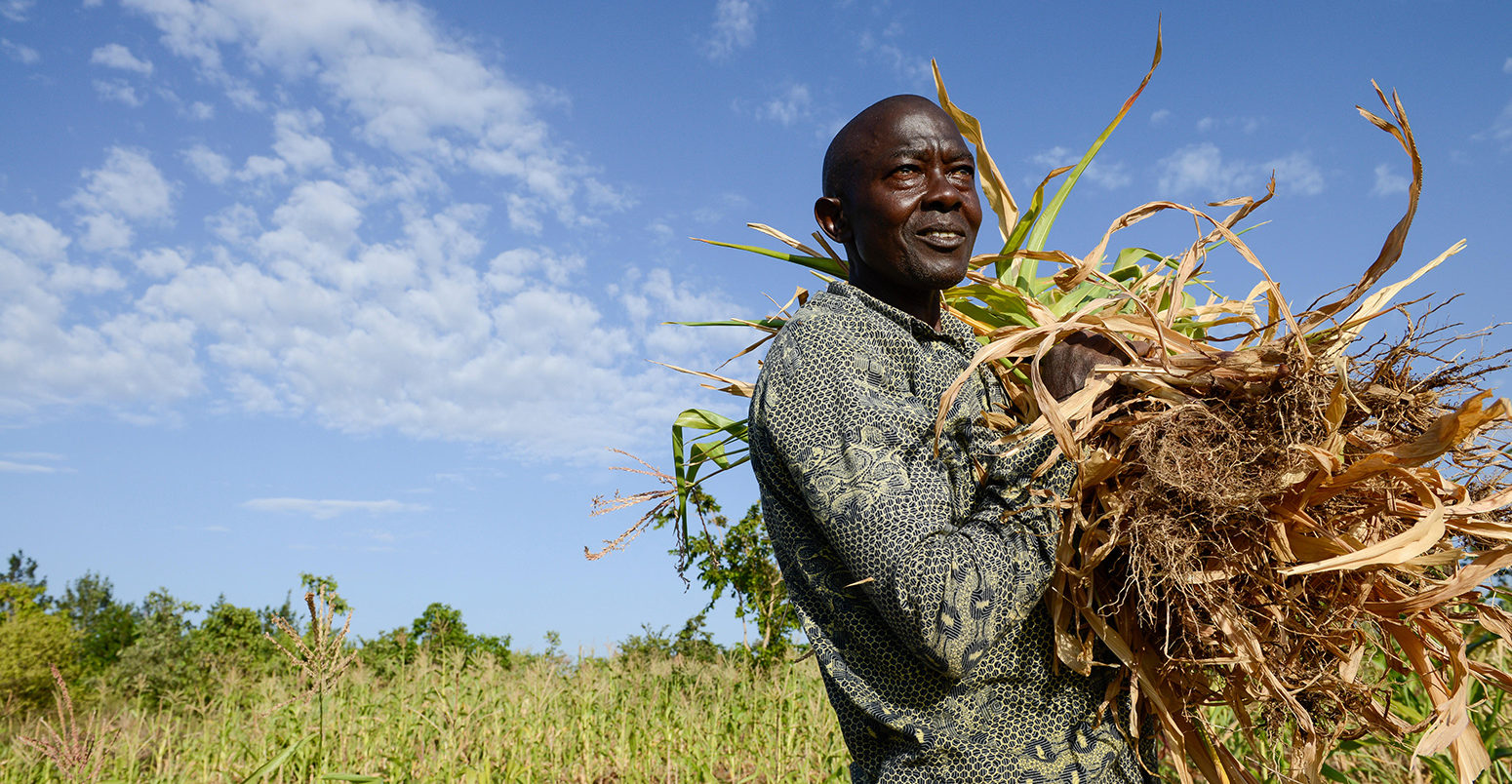
Guest post: Climate change could heighten risk of global food production ‘shocks’

Dr Michelle Tigchelaar
06.11.18
Dr Michelle Tigchelaar
11.06.2018 | 8:00pmDr Michelle Tigchelaar is a postdoctoral researcher at the University of Washington, currently investigating the impacts of climate change on global food security.
The 1972-74 food price crisis is the stuff of policy legend. At a time when grain prices had been declining for decades, the global price of wheat tripled in the space of just three years.
The trigger was a poor wheat harvest throughout the major breadbaskets of southeast Ukraine and southwest Russia, ravaged by an extremely hot summer with average temperatures 2-4C warmer than usual.
The effects of the resulting “Russian Wheat Deal” – in which the USSR purchased 10m tonnes of US wheat – rippled across the global food market and global grain prices soared.
Since the early 1970s, global food markets have only become more integrated. Just three staple crops – corn, wheat and rice – account for more than half of global calorie intake. For each of these crops, just three countries produce at least 40% of global production.
With growing demands for food, animal feed and biofuels, this leaves the global food market exposed to further price shocks. In 2007-08, for example, the overstretched grain market needed only relatively small crop losses in Australia (caused by heatwaves), record-high oil prices and poor policy choices to cause the world food crisis of 2007-08. The result was a doubling of cereal prices and food riots in dozens of countries.
In a new paper, published in Proceedings of the National Academy of Sciences, my colleagues and I show that climate change will heighten the risk of production shocks across the world’s biggest crop producers.
Optimum temperature threshold
The summer of 1972 was one of the 10% hottest Ukrainian summers of the last century. But, by the middle of this century, these kind of summers could become the norm, if global carbon emissions continue unabated.
High temperatures hurt plant development in multiple ways, including reduced plant fertility, reduced growth of the grain kernels, and increased water and energy use.
Modern-day crops have been bred and selected over decades and centuries to thrive in our climate, but they perform poorly beyond an optimum temperature threshold.
You can see this in the chart below. It shows an illustration of how crop yields vary with average temperature – rising to a peak (indicated by the black diamond) in the most favourable conditions, before declining again as temperatures increase further.
An increase in global temperature causes a shift further to the right on this curve (see red dot). In this warmer world, crop yields will not only be lower on average, but also more volatile on a year-to-year basis as conditions exceed optimum levels more frequently.
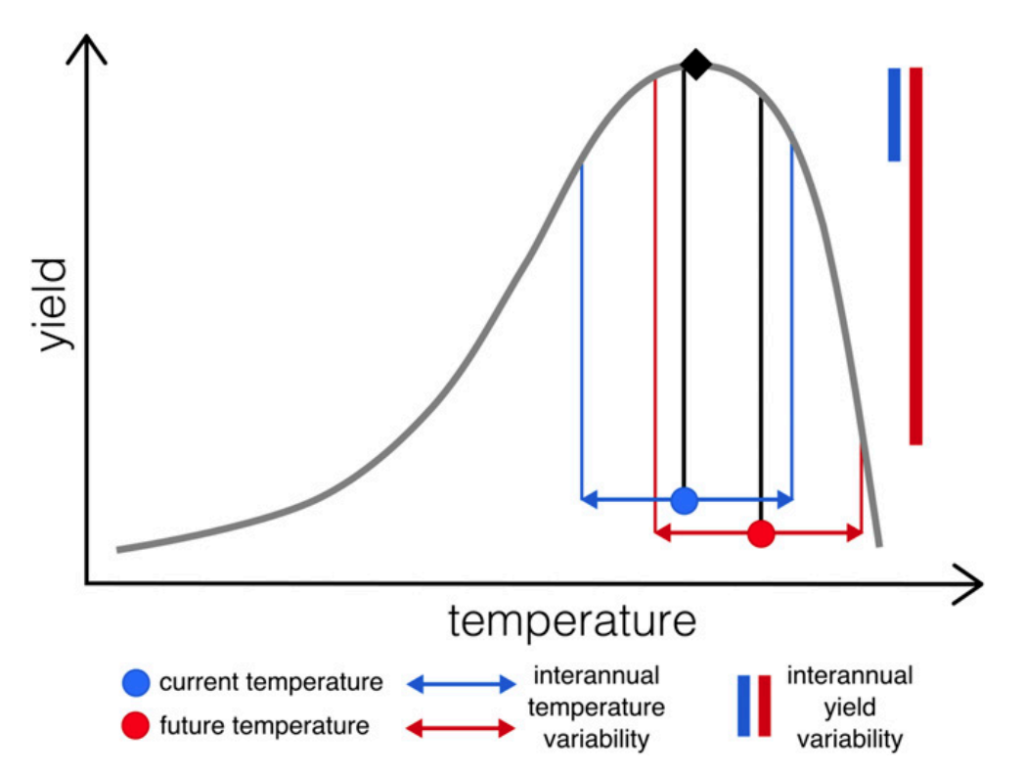
Schematic representation of temperature-yield relationship: in the absence of breeding for heat tolerance, an increase in mean temperature beyond the optimum temperature (♦) will lead to a decrease in mean yield and an increase in yield variability, assuming year-to-year temperature variability stays the same. Source: Tigchelaar et al. (2018)
Corn yields
In our study, my colleagues from the University of Washington, Stanford University and University of Minnesota and I combine data of past corn yields and climate variability with future climate projections to assess how likely corn production shocks will become in world that is 2C or 4C warmer than pre-industrial levels.
Corn is the most grown crop in the world by volume. It plays an important role in international food markets due to its multiple uses – not just for human consumption, but also as an animal feed, a sweetener and a biofuel. We find that in nearly all locations where corn is currently grown, yields will decrease in response to warming.
You can see this in the maps below, which show projected corn yield changes under 2C (left) and 4C (right) of warming. The shading shows yield gains (green) and declines (purple).
Four countries – the US, China, Brazil and Argentina – produce more than two thirds of the world’s corn. In these countries, we project that the mean total production will decline by 8-18% if the planet warms by 2C, and 19-46% with 4C of global warming.
This greatly outweighs the small areas of projected yield increases in western Europe and southern China.
Currently, on average, 986m tonnes of corn are produced globally each year – 125m tonnes of which are traded internationally. Our work suggests that in response to 2C of global warming, total production in the top four corn exporters (the US, Brazil, Argentina and Ukraine) would decline by 53m tonnes – equivalent to around 43% of current global exports.
For 4C of warming, projected production declines in these countries increase to 139m tonnes, which equals 14% of current global production and exceeds present day exports.
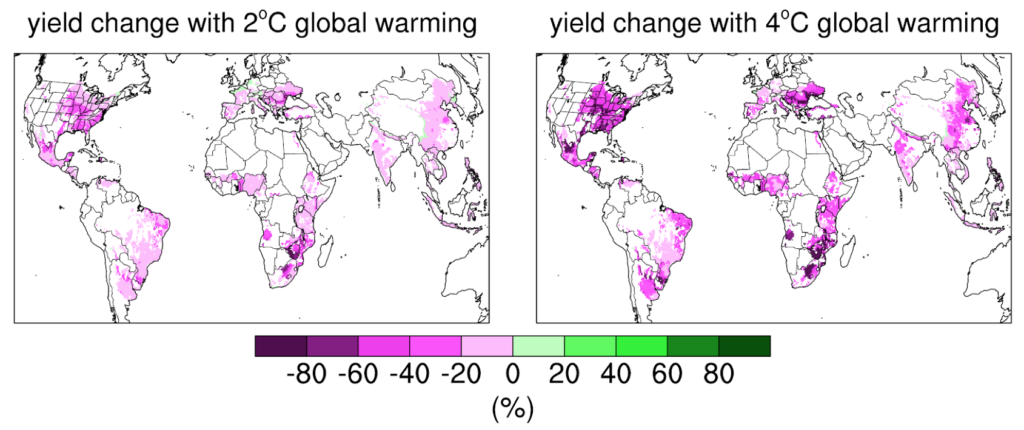
Warming-induced changes in average corn yield: Change in average yield (%) following annual mean global warming of 2C (left) and 4C (right). Shading indicates yield increases (green) or decreases (purple). Source: Tigchelaar et al. (2018)
Increasing volatility
Our findings also indicate that not only will average corn yields drop, but that their volatility will increase.
Extreme crop losses in large producing areas are rare: only every 15-to-100 years do we see yield losses greater than 10% and those greater than 20% are virtually unseen.
But these kind of losses become increasingly likely in a warmer climate. This is illustrated in the charts below. They show the probability of different yield levels for the six largest corn producing countries under today’s climate (black line), 2C of warming (blue) and 4C of warming (red).
From the black lines, you can see that yields tend to vary by a maximum of around 20% either side of average (zero on the x axis). But, as the world warms, this variability widens, with large below-average yields becoming increasingly possible.
In the Ukraine, for example, our projections suggest that under 4C of global warming there will be occasional years in which the entirety of the crop is lost.
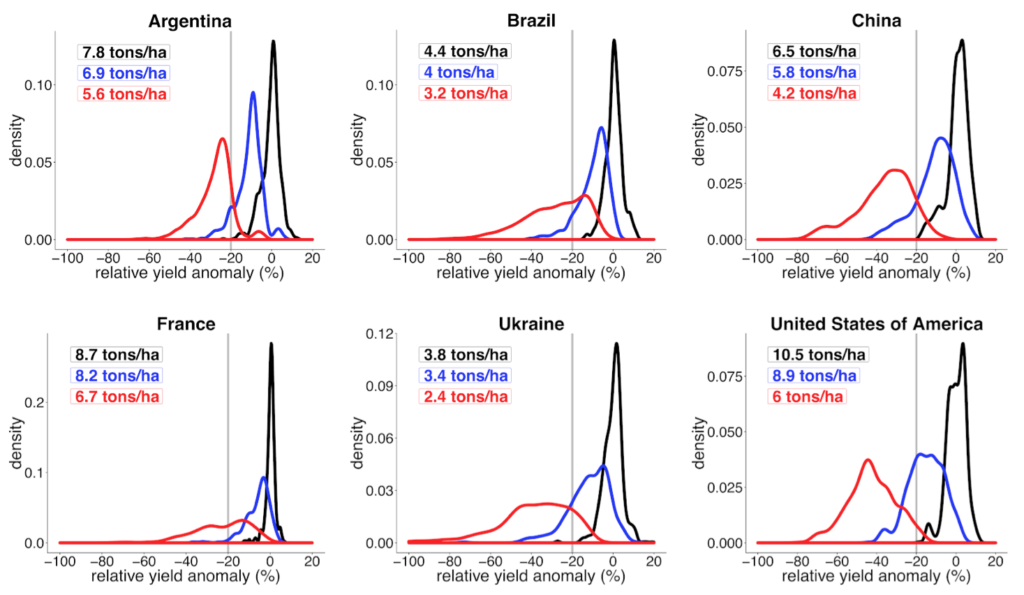
Warming-induced changes in yield variability in top-producing regions of the six largest corn producing and exporting countries: Probability density functions of yield anomalies with respect to present-day average yield for present-day climate (black), following 2C of global warming (blue), and following 4C of global warming (red). The vertical gray line denotes a relative yield reduction of 20% and boxed values indicate mean present-day yield in these areas for present-day climate (1999–2008; black) and for 2C (blue) and 4C (red) warming. Source: Tigchelaar et al. (2018)
Production shocks
The risk of simultaneous crop failures across multiple corn exporters is also expected to increase in a warmer climate.
Today, the chance of the top four corn exporters having production losses of more than 10% in the same year is close to zero. However, our findings suggest this likelihood increases to 7% under 2C warming and 86% under 4C.
Such synchronised production shocks are likely to have tremendous impacts on global cereal markets.
Volatility in global grain prices can result from food production shocks in both exporting countries (reducing supply) and importing countries (increasing demand). Simultaneous production shocks amongst these trading countries will impact those who rely on international trade for affordable food supplies: urban consumers, agribusiness, grain producers, the 2.5 billion people who spend most of their income on food, or the many more people that will populate the planet by 2050.
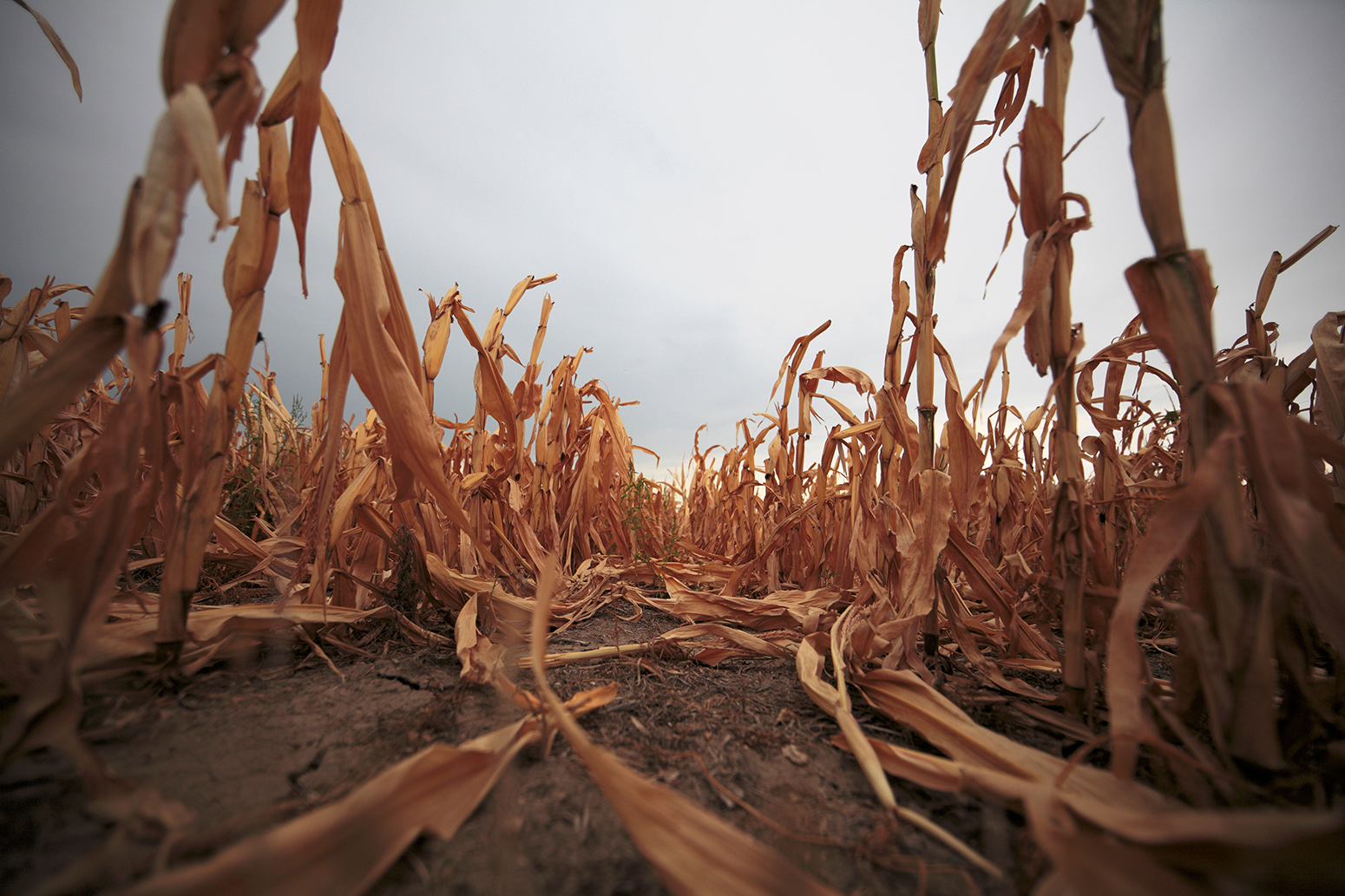
A failed corn crop, stunted and damaged by drought, Nebraska, 2012. Credit: LorenRyePhoto/Alamy Stock Photo.
Trade policies – and the extent to which they aim to insulate domestic markets from international price fluctuations – play a crucial role in either amplifying or mitigating the effects of global market volatility. With demand for grains on the rise and governments increasingly intervening in staple grain markets, the pattern of high price volatility of the last decade will likely persist – and be intensified by a warming climate.
Rising temperatures are by no means the only threat to our global food system: competition for water, a growing population and a growing consumption of animal protein, as well as degradation of fertile land all play their part. Climate change is an unwelcome guest to this party of challenges.
The 2C and 4C warming scenarios used in our study present vastly different visions of the future. A 2C warming limit is enshrined in the Paris Agreement, but current commitments are insufficient to get us there. Warming the planet by 4C would take another eight or so decades of emitting carbon at our current rates.
With 1C of global warming so far, technological yield gains have been able to outpace the negative impacts of a warmer climate. But unless major gains are achieved in breeding crops for heat tolerance, avoiding a low-yield, high-volatility future rests heavily on how quickly global CO2 emissions can be curtailed.
Tigchelaar, M., Battisti, D. S., Naylor, R. L. and Ray, D. K. (2018) Future warming increases probability of globally synchronized maize production shocks, Proceedings of the National Academy of Sciences, doi:10.1073/pnas.1718031115
-
Guest post: Climate change could heighten risk of global food production ‘shocks’
-
Guest post: How climate change could trigger global food production ‘shocks’

